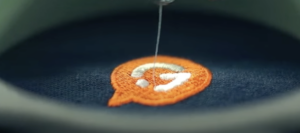One of the biggest questions surrounding is: is it eco-friendly?
While the standard technique might not be, there are options which make screen printing incredibly good for the environment. Find out moreWhen it comes to screen printing ink, there are two different types of inks that can be used: plastisol ink and water-based ink. Plastisol is the industry standard and the default ink used by commercial printers. It uses a polyvinyl chloride (PVC) base, as opposed to water-based ink, which is exactly what its name suggests, a water-based ink with pigments suspended within it.
The limitation associated with water-based inks is that you can not print onto dark coloured garments, but they are excellent for printing vibrant colours onto lighter coloured garments. Furthermore, the print result is affected by the colour of the garment. For example, using a purple coloured shirt may change the appearance of the ink colour. Water-based inks also do not work well on all materials and are better suited for shorter run orders. For printing soft prints onto dark coloured garments there is a screen printing technique that uses discharge water-based inks.
Benefits of using water-based screen printing:
Water-based inks are very useful because of their versatility and ability to print a wide range of items. They can be used to print onto non-textile items like stickers, stationery, and canvas, as well as garments such as T Shirts, polo’s, hoodies, sweatshirts, caps, tote bags, jackets, aprons and virtually any other garment that can be placed on a platen to be screen printed.
Water-based inks works well with cotton, polyester and poly-cotton blends.In the screen printing industry, the term ‘hand’ refers to how soft a print feels to the touch. Plastisol inks, for example, are well known for the maximum or hand hand that they provide. Water-based inks result with minimal or soft hand onto printed garments, much like direct to garment (DTG) digital printing that is practically seamless to the touch. An added benefit with water-based inks is that they can be ironed over, while plastisol prints cannot because the iron can easily melt the PVC into the ink.
Water-based prints produce colours that are often much more vibrant than plastisol prints. After proper curing, a T-Shirt or other printed garment with a water-based print will be likely to outlast the fabric on which it was printed. Due to the minimal hand of water-based prints, very large and detailed designs printed onto a garment will feel light and thin, while the same design printed using plastisol inks will be much heavier because of the thickness of the ink layers.
Garments which are printed using water-based inks are also likely to be much more comfortable to wear. Since water-based inks penetrate the printed fabric, rather than sit on top like with plastisol inks, skin under the printed garment can breath easier.Water-based ink is an environmentally friendly printing option. After a printing run, screens and printing equipment can be washed off using conventional water, and it is safe to go down the drain unfiltered.
Water-based inks are non-toxic and do not contain any lead or heavy metals, nor do they contain o-zone depleting chemicals like chlorofluorocarbons (CFC’s) or other volatile solvents.
PVC based inks and the environment:
Plastisol is a PVC based ink which is a carcinogen known to cause serious hazards in the environment and to be harmful for human beings. Plastic is damaging the natural world and its ecosystems while having drastic consequences on life and the future sustainability of our planet. As ‘greener’ efforts begin (and have already begun!) influencing the collective consciousness of humanity and industries start turning away from plastic in as many ways as possible, this also includes the preference of screen printing inks that people purchase to wear. PVC inks, like plastisol, are not drain safe.
Printers using plastisol must resort to dangerous and environmentally harmful chemicals to break down plastisol from printing equipment and screens. Specially designed filters must be installed on drains to catch PVC particles. Many commercial printers are diligent in taking precautions, but unfortunately, many do not.
Plastisol is popular and loved by printers because it is relatively inexpensive and very well suited for mass productions and large run orders because it does not dry and clog printing equipment. Plastisol never dries, it stays in a semi-liquid state until it is cured at a temperature until the water in the ink has completely evaporated, leaving behind just the pigment colours.
Water-based ink advantages:
- ‘Soft hand’ prints.
- Eco-friendly.
- Beautiful, vibrant colours.
- Excellent for printing onto lighter-coloured garments.
Water-based ink disadvantages:
- Can not print onto darker garments.
- Inks are affected by the garment colour.
- Not well suited for printing onto all materials.
- Plastisol inks are better for larger print runs.
In a hurry? Use our Quick Quote Calculator.
Provide us with all your project details and our expert team will provide you with the best options and associated costs. It couldn’t be easier to get the exact product at the best price.




